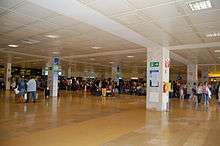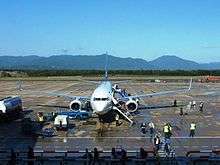Girona–Costa Brava Airport
| Girona–Costa Brava Airport Aeroport de Girona-Costa Brava | |||||||||||
|---|---|---|---|---|---|---|---|---|---|---|---|
|
| |||||||||||
| Summary | |||||||||||
| Airport type | Public | ||||||||||
| Owner | Aeropuertos Españoles y Navegación Aérea (AENA) | ||||||||||
| Serves |
Girona, the Costa Brava and Barcelona, Spain | ||||||||||
| Elevation AMSL | 143 m / 469 ft | ||||||||||
| Coordinates | 41°54′03″N 002°45′38″E / 41.90083°N 2.76056°ECoordinates: 41°54′03″N 002°45′38″E / 41.90083°N 2.76056°E | ||||||||||
| Website | aena-aeropuertos.es | ||||||||||
| Map | |||||||||||
 GRO Location within Catalonia | |||||||||||
| Runways | |||||||||||
| |||||||||||
| Statistics (2016) | |||||||||||
| |||||||||||
|
Source: AENA[1] | |||||||||||
Girona–Costa Brava Airport (IATA: GRO, ICAO: LEGE) (Catalan: Aeroport de Girona-Costa Brava, Spanish: Aeropuerto de Girona-Costa Brava) is an airport located 12.5 km (7.8 mi) southwest[2] of the city of Girona, next to the small village of Vilobí d'Onyar, in the north-east of Catalonia, Spain. The airport is well connected to the Costa Brava and the Pyrenees. Girona Airport is used as an alternative airport for Barcelona as well, even though the airport is 92 km (57 mi)[3] north of Barcelona.
History
The airport was built in 1965,[4] but passenger traffic was modest.
The early 2000s saw passenger numbers grow spectacularly after Ryanair chose Girona as one of its European hubs. In 1993, Girona Airport dealt with only 275,000 passengers; in the six years from 2002 to 2008 passenger numbers increased by nearly ten times from just over 500,000 to more than 5.5 million, but half of these were lost again in the next 4 years until 2012 with only 2.8 million passengers.[5] 2014 saw less than 2.2 million passengers pass through the airport. In 2016 it carried just 1.6 million passengers.
Facilities
The airport consists of one two-storey passenger terminal building. On the ground floor there are 33 check-in desks, with 11 boarding gates on the first floor for both domestic and international flights.[6] Food is available in the departures area of the airport, as well as a few shops.
Airlines and destinations
The following airlines operate regular scheduled and charter flights to and from Girona:[7]
Statistics
 |
| Updated: 16 January 2015.[5] 2015 data provisional. |


The following table shows total passenger numbers at Girona Airport from 1997 to date.
| Year | Passengers |
|---|---|
| 1997 | 533,445 |
| 1998 | 610,607 |
| 1999 | 631,235 |
| 2000 | 651,402 |
| 2001 | 622,410 |
| 2002 | 557,187 |
| 2003 | 1,448,796 |
| 2004 | 2,962,988 |
| 2005 | 3,533,567 |
| 2006 | 3,614,223 |
| 2007 | 4,848,604 |
| 2008 | 5,507,294 |
| 2009 | 5,286,970 |
| 2010 | 4,863,785 |
| 2011 | 3,007,649 |
| 2012 | 2,844,571 |
| 2013 | 2,736,867 |
| 2014 | 2.160.646 |
| 2015 | 1.775.318 |
| 2016 | 1.664.763 |
| Source: Aena Statistics[5] | |
Ground transportation
Alongside being an alternative option to Barcelona Airport, Girona Airport is convenient for the resorts along the Costa Brava, such as Lloret de Mar, l'Estartit and Blanes. It is about a 40-minute drive from the French border and many people use Girona Airport as a way of getting to the Pyrenees and the ski resorts of Andorra.
By car
The airport is served by three main roads:
- E-15/AP-7 toll road (Perpignan, France – south of Spain)
- C-25 (Lleida – Vic – Girona)
- N-II, no-toll road (Madrid – Barcelona – Perpignan, France)
By bus
There are 6 bus lines operating in the airport to:
- Barcelona
- Costa Brava/Maresme (stops at Tossa de Mar, Lloret de Mar, Blanes, Malgrat de Mar, Santa Susanna, Pineda de Mar and Calella de la Costa)
- North Costa Brava (stops at Figueres, Roses, Pineda de Mar, Calella de Palafrugell and Tossa de Mar)
- Girona (25 minutes, one every hour)
- Perpignan in France.
- Andorra
By train
The closest main line railway station to the airport is in Girona. The closest railway station is in fact Riudellots Halt, 4 km away from the airport.[9] There is a project to build a station for the AVE line LGV Perpignan–Figueres.
Incidents and accidents
- On 14 September 1999, at 21:47 UTC, a Boeing 757–204 charter flight from Cardiff, Wales, UK, with 236 passengers and 9 crew left the runway when landing in a storm and broke apart. After leaving the runway, it ran 343 metres across flat grassland beside the runway, before going diagonally over a substantial earth mound adjacent to the airport boundary, becoming semi-airborne as a result. Beyond the mound it hit and severed a number of medium-sized trees and the right engine struck the boundary fence. The aircraft then yawed considerably to the right, passed through the fence, landed again in a field, and its main landing gears collapsed. It finally stopped after a 244-metre slide across the field. Damage was substantial: the fuselage was broken in two places and the landing gear and both engines detached. Remarkably, there were no immediate fatalities but 44 people, including the aircraft's captain, received hospital treatment for severe to minor injuries.[10][11]
References
- ↑ Informes Anuales – 2012 – AENA
- ↑ Spanish AIP (AENA) Archived 7 March 2012 at the Wayback Machine.
- ↑ ViaMichelin : Itinéraire, Route, Plan, Carte de France, Plan de Ville, Carte Europe
- ↑ "AENA Girona-Costa Brava Historia". Retrieved 9 January 2014.
- 1 2 3 AENA passenger statistics and aircraft movements
- ↑ Girona Airport
- ↑ aena.es - Destinos retrieved 21 May 2017
- ↑ http://www.jet2.com/timetable
- ↑ 3 PM Barcelona to Cerbere train schedule
- ↑ "Special Bulletin S1/2000 – Boeing 757–204, G-BYAG" (PDF). Air Accidents Investigation Branch. 2000. Archived from the original (PDF) on 4 October 2006.
- ↑ "BBC report of air crash". BBC. 1999-09-16.
External links
![]() Media related to Girona-Costa Brava Airport at Wikimedia Commons
Media related to Girona-Costa Brava Airport at Wikimedia Commons
- Official website (Aena)
- Current weather for LEGE at NOAA/NWS
- Accident history for GRO at Aviation Safety Network